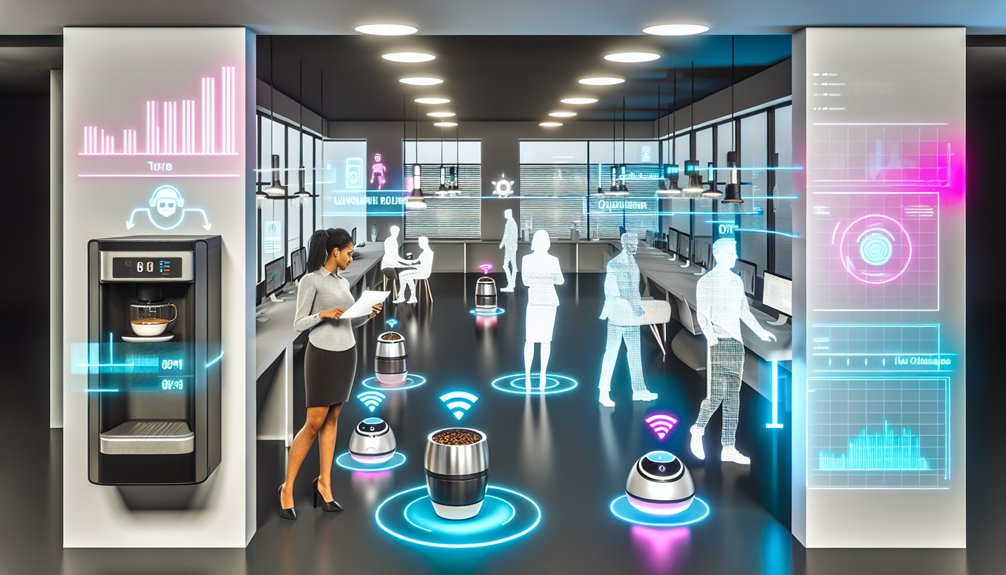In 2025, IoT will transform small businesses with innovations like real-time inventory tracking and energy-efficient operations. Expect smart supply chains with RFID and sensors minimizing errors and advanced demand forecasting optimizing stock levels. With smart grids and automation, cut operational costs considerably.
Enhance security through biometric authentication and encrypted communications safeguarding data. Improve customer engagement using IoT devices integrated with CRM for tailored interactions. Utilize remote collaboration tools for a more secure and productive workforce. These technologies not only enhance efficiency but also elevate customer satisfaction and security. Explore further to harness these powerful innovations effectively.
Key Takeaways
- IoT-enabled inventory systems provide real-time stock visibility and automated data updates, reducing manual errors for small businesses.
- Energy-efficient smart grids and monitoring systems lower operational costs and enhance sustainability for small enterprises.
- Advanced security measures like biometric authentication and encrypted communications protect small businesses from cyber threats.
- IoT devices enhance customer engagement by collecting real-time data to tailor marketing strategies and improve service.
- Remote collaboration tools powered by IoT enable seamless communication and productivity for small business teams.
Smart Inventory Management
In today’s fast-paced market, smart inventory management is essential for small businesses aiming to stay competitive. By leveraging IoT technology, you can implement real-time tracking systems that provide instant visibility into your inventory levels.
These systems use RFID tags and sensors to automatically update stock data, reducing manual errors and helping you maintain ideal inventory levels. With real-time tracking, you can react quickly to changes in demand, preventing stockouts and overstock situations that could affect your bottom line.
Furthermore, advanced demand forecasting tools powered by IoT can analyze historical sales data, market trends, and other relevant factors to predict future inventory needs more accurately.
By integrating these forecasts into your inventory management strategy, you can make data-driven decisions that align your stock levels with customer demand, improving your service efficiency and customer satisfaction.
IoT-enabled systems allow for seamless communication between devices, ensuring that your supply chain remains agile and responsive to changes in the market.
Embracing these innovations not only streamlines your operations but also sets the stage for sustainable growth.
In a competitive landscape, staying ahead with cutting-edge technology can be the key to long-term success.
Energy-Efficient Systems
After enhancing your inventory management with IoT, it’s time to harness technology for energy efficiency within your small business. By integrating renewable energy and smart grids, you can greatly reduce operational costs.
Incorporate energy monitoring systems with IoT sensors to track and improve usage patterns. This allows you to implement building automation solutions that control HVAC systems through advanced thermal management, ensuring you’re not wasting energy.
Demand response technologies enable your business to adjust power consumption during peak periods, which can lead to considerable savings. Energy analytics will provide insights into usage trends, helping you make data-driven decisions to reduce consumption.
Smart lighting systems offer automated control based on occupancy, further enhancing efficiency.
Consider these key innovations for an energy-efficient future:
- Energy Storage Solutions: Use cutting-edge batteries to store renewable energy generated on-site, reducing reliance on the grid.
- IoT-Driven Smart Lighting: Implement systems that adapt to natural light levels, ensuring ideal energy use.
- Comprehensive Thermal Management: Improve HVAC with IoT sensors to maintain comfort without excess energy usage.
Advanced Security Solutions
Guaranteeing the security of your small business is paramount in today’s interconnected world. By 2025, advanced security solutions will leverage IoT technology to safeguard your operations.
You’ll find biometric authentication increasingly crucial, offering superior access control. This method uses unique biological traits like fingerprints or retinal scans, guaranteeing only authorized personnel gain access. According to a recent study, biometric systems reduce unauthorized access attempts by 75%, making it a compelling choice for your business.
Encrypted communications are another essential component of your security strategy. With sensitive data being transmitted over IoT networks, implementing robust encryption protocols is non-negotiable. End-to-end encryption guarantees that data remains secure from the source to the destination, considerably lowering the risk of cyber threats.
In 2025, expect encryption algorithms to evolve, providing even stronger data protection.
Integrating these advanced security solutions into your IoT framework will help mitigate risks associated with cyber-attacks. You’ll safeguard not only your assets but also the trust of your customers.
As attackers become more sophisticated, staying ahead with cutting-edge security solutions is critical. Your proactive approach will be the cornerstone of a resilient and secure business environment.
Connected Customer Experiences
Small businesses’ success increasingly hinges on delivering connected customer experiences that leverage IoT technology. In 2025, IoT devices enable you to gather real-time data, offering insights into customer preferences and behaviors. This data helps you craft personalized services, ensuring that each customer interaction is unique and relevant.
By integrating IoT with customer relationship management (CRM) systems, you can automate and tailor communications, fostering deeper connections with your audience.
IoT also streamlines the collection of customer feedback, essential for continuous improvement. With smart devices, customers can instantly share their experiences, allowing you to respond quickly and make data-driven decisions. This feedback loop enhances your ability to adapt to market demands and remain competitive.
Consider these IoT-driven strategies for connected customer experiences:
- Smart Beacons: Utilize IoT beacons to send personalized offers to customers’ smartphones as they enter your store, increasing engagement and sales.
- Connected Devices: Implement IoT sensors to monitor product usage, providing data that informs upselling opportunities or service enhancements.
- Automated Feedback Systems: Deploy IoT-enabled kiosks or apps for real-time feedback, enabling immediate customer issue resolution and satisfaction tracking.
Adopting these IoT innovations positions your business to deliver superior, connected experiences, driving growth and customer loyalty.
Predictive Maintenance Tools
Predictive maintenance tools revolutionize how small businesses manage their equipment and operations by leveraging IoT technology to predict and prevent failures.
By integrating sensor analytics with machine learning, you can monitor the health of your machinery in real-time, identifying patterns that signal potential issues before they escalate. This approach allows you to schedule maintenance activities efficiently, reducing downtime and extending the lifespan of your equipment.
Incorporating sensor analytics, you gather data from various operational metrics like temperature, vibration, and lubrication levels. Machine learning algorithms then process this data, identifying trends and anomalies that could lead to equipment failure.
According to recent studies, businesses using predictive maintenance have reduced maintenance costs by up to 25% and improved equipment uptime by 20%.
Automated Supply Chain
Implementing an automated supply chain can transform your small business operations by streamlining processes and enhancing efficiency. By integrating IoT technologies, you can revolutionize how you manage inventory, transportation, and logistics.
Real-time tracking allows you to monitor the movement of goods at every stage, providing insights into potential bottlenecks before they become costly delays. This visibility guarantees that you can react swiftly to changes, maintaining ideal flow and reducing waste.
Demand forecasting, powered by AI and machine learning, predicts customer needs with impressive accuracy. By analyzing historical sales data and market trends, you can adjust procurement schedules and production levels to match demand.
This proactive approach minimizes overstocking and stockouts, leading to cost savings and improved customer satisfaction.
With an automated supply chain, you can expect:
- Increased operational efficiency: Eliminate manual processes and reduce errors with automated systems.
- Enhanced decision-making: Access data-driven insights for better strategic planning.
- Improved customer service: Deliver products faster and more reliably by optimizing logistics.
Investing in these technologies today prepares your business for the competitive landscape of 2025, guaranteeing you stay ahead in an ever-evolving market.
Embrace this innovation to drive growth and success.
IoT-Driven Marketing Strategies
In today’s data-centric marketplace, IoT-driven marketing strategies have become essential for small businesses looking to gain a competitive edge. Leveraging IoT devices allows you to gather real-time data from customer interactions, enabling personalized advertising that resonates with individual preferences.
By integrating IoT with advanced data analytics, you can gain insights into consumer behavior, optimize marketing campaigns, and improve customer engagement.
IoT devices, such as smart sensors and beacons, collect valuable data points—like foot traffic patterns and in-store dwell times—that inform your marketing decisions. This data, when analyzed effectively, helps tailor your promotional efforts to target specific customer segments, increasing the likelihood of conversion.
Personalized advertising becomes seamless as IoT-driven insights allow you to deliver the right message at the right time, whether through mobile notifications or digital signage.
Furthermore, IoT-enabled platforms can automate the collection and analysis of customer feedback, guaranteeing your marketing strategies adapt to evolving consumer demands.
By embracing IoT-driven marketing, you’re not just reacting to trends but actively shaping them, positioning your small business at the forefront of innovation and customer satisfaction.
This forward-thinking approach guarantees your business remains agile and competitive in the ever-evolving marketplace.
Remote Workforce Solutions
As you explore IoT innovations for remote workforce solutions, consider leveraging seamless virtual collaboration tools that enable real-time communication with latency as low as 20 milliseconds.
Integrating smart office management systems can optimize energy use by up to 30%, while maintaining a productive environment remotely.
Additionally, implementing enhanced cybersecurity measures, such as AI-driven threat detection, can reduce data breach risks by 60%, ensuring your business’s digital safety.
Seamless Virtual Collaboration Tools
Frequently, the success of a remote workforce hinges on the efficiency of virtual collaboration tools. By 2025, seamless virtual collaboration is no longer a luxury but a necessity driven by IoT innovations.
You’ll find cloud-based platforms have become the backbone of these tools, offering agility and scalability that traditional systems can’t match. Real-time feedback mechanisms are integral, enabling instant communication and adjustments, which greatly increase productivity.
To leverage these advancements, you should prioritize:
- Cloud Integration: Confirm your collaboration tools are fully integrated with cloud-based platforms. This enables easy access to data and resources from anywhere, enhancing team flexibility.
- Data Security: With increased use of IoT devices, ascertain robust security protocols are in place to protect sensitive information during virtual interactions.
- User Experience: Invest in tools that offer intuitive interfaces and seamless navigation to reduce the learning curve and improve adoption rates.
Smart Office Management Systems
Smart office management systems form the cornerstone of effective remote workforce solutions by leveraging IoT technology to optimize operational efficiency.
By 2025, these systems will integrate seamlessly into your business, using smart workspace design to transform any location into a dynamic work environment. IoT sensors will regulate lighting, temperature, and air quality, tailoring conditions to boost productivity and reduce energy consumption. This level of automation not only saves costs but also enhances employee comfort, fostering a productive work setting.
Data-driven employee engagement tools will further revolutionize how you connect with your remote team. These tools will track and analyze workflow patterns, offering insights into employee performance and engagement. Using this data, you can implement personalized strategies to maintain morale and productivity.
For instance, IoT-enabled feedback systems will allow real-time communication, guaranteeing that your team feels heard and valued.
Moreover, predictive analytics will anticipate workload peaks and employee burnout risks, allowing for preemptive interventions. Smart office management systems will also enable efficient resource allocation, guaranteeing that your team has access to the tools and support they need, wherever they are.
Enhanced Cybersecurity Measures
Embracing IoT in your business strategy requires robust cybersecurity measures to protect sensitive data and maintain trust. As remote work becomes the norm, making sure that your IoT devices are secure is essential. Start by implementing data encryption to safeguard information as it travels across networks. Threat detection systems are important—they continuously monitor for anomalies, providing early warnings of potential breaches.
- Access control: Implement multi-factor authentication to guarantee only authorized personnel have access to critical systems.
- Network segmentation: Divide your network into isolated segments to contain breaches and limit unauthorized movement.
- Incident response: Develop a thorough plan to quickly address and mitigate security incidents, minimizing damage and downtime.
Conduct regular risk assessments to identify vulnerabilities within your IoT ecosystem. This proactive approach helps in vulnerability management, making sure that you patch weaknesses before they’re exploited.
Compliance solutions are also essential, making certain your business adheres to industry standards and regulations, like GDPR or CCPA, which can protect against legal repercussions.
Frequently Asked Questions
What Are the Potential Cybersecurity Risks Associated With Iot Devices for Small Businesses?
You’re likely aware that IoT vulnerabilities pose significant cybersecurity risks.
Data breaches can occur if unauthorized access exploits weak device management protocols. Properly managing these devices is essential to prevent potential threats.
Implementing robust security measures helps mitigate risks, ensuring sensitive data remains protected. Regular updates and strong authentication processes will strengthen your IoT devices’ defenses, safeguarding your small business against potential cyber-attacks.
Stay proactive to secure your digital assets.
How Can Small Businesses Ensure Data Privacy With Iot Technology?
To guarantee data privacy with IoT technology, you should implement strong data encryption to protect information in transit and at rest.
Additionally, employ robust user authentication methods, like multi-factor authentication, to verify user identities and prevent unauthorized access.
Regularly update firmware and software to patch vulnerabilities.
Conduct regular security audits to identify potential risks and stay ahead of emerging threats.
This proactive approach secures sensitive data and maintains customer trust.
What Are the Costs Involved in Implementing Iot Solutions for Small Businesses?
When considering IoT solutions, you’ll need to think about budget considerations. Initial costs include devices, software, and connectivity.
You’ll also face ongoing expenses like maintenance and data management. Implementation strategies should focus on scalable solutions to manage costs effectively.
Investing in reliable technology reduces long-term expenses. Evaluate ROI through increased efficiency and productivity.
Forward-thinking planning guarantees your IoT system aligns with business growth while staying technically sound and cost-efficient.
How Do Iot Devices Integrate With Existing Business Systems?
When integrating IoT devices with your existing business systems, you might face IoT compatibility challenges.
Verify your systems support IoT protocols like MQTT or CoAP. Use middleware to bridge gaps between new devices and legacy systems. Doing so can streamline operations by automating data flow and enhancing real-time analytics.
Regularly update software to maintain seamless integration. Prioritize scalable solutions to accommodate future IoT expansions while minimizing disruptions to your operations.
What Training Do Employees Need to Effectively Use Iot Tools?
To effectively use IoT tools, you’ll need to guarantee employees undergo hands-on workshops that focus on practical applications and real-world scenarios.
These workshops should be complemented by ongoing support to address any technical challenges.
Data-driven training sessions can enhance understanding of IoT analytics, guaranteeing employees can leverage insights for business growth.
Conclusion
By embracing IoT innovations, you’ll unleash transformative potential for your small business. Smart inventory management and energy-efficient systems can cut costs by 30%, while advanced security solutions protect critical data. Enhance customer satisfaction with connected experiences and leverage predictive maintenance tools to reduce downtime by 50%. Automate your supply chain, implement IoT-driven marketing for precise targeting, and support remote work seamlessly. These strategies guarantee your business stays competitive and agile in 2025 and beyond.










